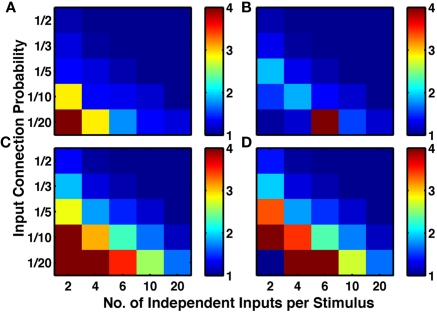Figure 5.
Inhibitory plasticity boosts numbers of bidirectional connections between excitatory cells. Sets of five by five networks with different degrees of sparseness of inputs (y-axis where low input probability reflects high sparseness of inputs) and different degrees of input correlations (x-axis where more input groups per stimulus reflects lower correlations). (A) Network with structural plasticity alone. (B) Network with triplet-STDP and structural plasticity. (C) Network with LTPi and structural plasticity. (D) Network with triplet-STDP, LTPi, and structural plasticity. In both cases (A–C) and (B–D), the addition of inhibitory plasticity increases the numbers of networks with excess bidirectional connections (color bar, red = 4 times chance, blue = chance). Networks trained for 2000 trials of the biconditional discrimination task.

